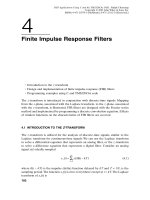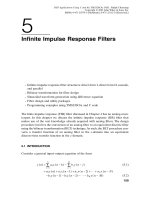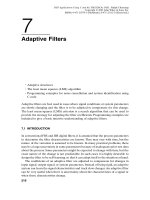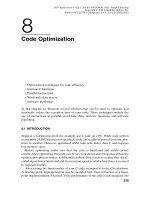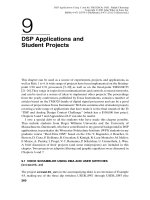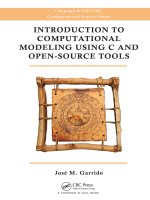IT training DSP applications using c and the TMS320C6x DSK chassaing 2002 02 11
Bạn đang xem bản rút gọn của tài liệu. Xem và tải ngay bản đầy đủ của tài liệu tại đây (4.63 MB, 354 trang )
DSP Applications Using C and the TMS320C6x DSK. Rulph Chassaing
Copyright © 2002 John Wiley & Sons, Inc.
ISBNs: 0-471-20754-3 (Hardback); 0-471-22112-0 (Electronic)
DSP Applications Using C
and the TMS320C6x DSK
TOPICS IN DIGITAL SIGNAL PROCESSING
C. S. BURRUS and T. W. PARKS: DFT/FFT AND CONVOLUTION
ALGORITHMS: THEORY AND IMPLEMENTATION
JOHN R. TREICHLER, C. RICHARD JOHNSON, JR., and MICHAEL G.
LARIMORE: THEORY AND DESIGN OF ADAPTIVE FILTERS
T. W. PARKS and C. S. BURRUS: DIGITAL FILTER DESIGN
RULPH CHASSAING and DARRELL W. HORNING: DIGITAL SIGNAL
PROCESSING WITH THE TMS320C25
RULPH CHASSAING: DIGITAL SIGNAL PROCESSING WITH C AND
THE TMS320C30
RULPH CHASSAING: DIGITAL SIGNAL PROCESSING LABORATORY
EXPERIMENTS USING C AND THE TMS320C31 DSK
RULPH CHASSAING: DSP APPLICATIONS USING C AND THE
TMS320C6x DSK
DSP Applications Using C
and the TMS320C6x DSK
Rulph Chassaing
A Wiley–Interscience Publication
JOHN WILEY & SONS, INC.
Designations used by companies to distinguish their products are often claimed as trademarks. In all
instances where John Wiley & Sons, Inc., is aware of a claim, the product names appear in initial
capital or all capital letters. Readers, however, should contact the appropriate companies for more
complete information regarding trademarks and registration.
Copyright © 2002 by John Wiley & Sons, Inc. All rights reserved.
No part of this publication may be reproduced, stored in a retrieval system or transmitted in any form
or by any means, electronic or mechanical, including uploading, downloading, printing, decompiling,
recording or otherwise, except as permitted under Sections 107 or 108 of the 1976 United States
Copyright Act, without the prior written permission of the Publisher. Requests to the Publisher for
permission should be addressed to the Permissions Department, John Wiley & Sons, Inc., 605 Third
Avenue, New York, NY 10158-0012, (212) 850-6011, fax (212) 850-6008, E-Mail:
This publication is designed to provide accurate and authoritative information in regard to the subject
matter covered. It is sold with the understanding that the publisher is not engaged in rendering
professional services. If professional advice or other expert assistance is required, the services of a
competent professional person should be sought.
ISBN 0-471-22112-0
This title is also available in print as ISBN 0-471-20754-3.
For more information about Wiley products, visit our web site at www.Wiley.com.
Contents
Preface
xi
List of Examples
xv
Programs/Files on Accompanying Disk
xix
1
DSP Development System
1.1
1.2
1.3
1.4
1.5
1.6
Introduction
DSK Support Tools
1.2.1
DSK Board
1.2.2
TMS320C6711 Digital Signal Processor
Code Composer Studio
1.3.1
CCS Installation and Support
1.3.2
Useful Types of Files
Programming Examples to Test the DSK Tools
1.4.1
Quick Test of DSK
1.4.2
Support Files
1.4.3
Examples
Support Programs/Files Considerations
1.5.1
Initialization/Communication File
1.5.2
Vector File
1.5.3
Linker File
Compiler/Assembler/Linker Shell
1.6.1
Compiler
1.6.2
Assembler
1.6.3
Linker
References
1
1
2
4
4
5
5
6
7
7
8
8
24
24
26
26
26
28
29
29
30
v
vi
2
3
Contents
Input and Output with the DSK
33
2.1
2.2
2.3
2.4
33
34
35
37
60
Introduction
TLC320AD535 (AD535) Onboard Codec for Input and Output
PCM3003 Stereo Codec for Input and Output
Programming Examples Using C Code
References
Architecture and Instruction Set of the C6x Processor
61
3.1
3.2
3.3
3.4
3.5
3.6
3.7
61
63
65
66
67
68
69
69
70
71
71
72
74
74
76
76
76
77
77
79
80
80
81
82
82
82
83
83
83
83
84
85
3.8
3.9
3.10
3.11
3.12
3.13
3.14
3.15
3.16
3.17
3.18
Introduction
TMS320C6x Architecture
Functional Units
Fetch and Execute Packets
Pipelining
Registers
Linear and Circular Addressing Modes
3.7.1
Indirect Addressing
3.7.2
Circular Addressing
TMS320C6x Instruction Set
3.8.1
Assembly Code Format
3.8.2
Types of Instructions
Assembler Directives
Linear Assembly
ASM Statement within C
C-Callable Assembly Function
Timers
Interrupts
3.14.1 Interrupt Control Registers
3.14.2 Selection of XINT0
3.14.3 Interrupt Acknowledgment
Multichannel Buffered Serial Ports
Direct Memory Access
Memory Considerations
3.17.1 Data Allocation
3.17.2 Data Alignment
3.17.3 Pragma Directives
3.17.4 Memory Models
Fixed- and Floating-Point Format
3.18.1 Data Types
3.18.2 Floating-Point Format
3.18.3 Division
Contents
3.19
3.20
3.21
3.22
4
85
85
86
86
86
87
87
87
88
88
89
90
100
Finite Impulse Response Filters
102
4.1
102
105
106
107
108
110
114
115
115
115
116
116
116
155
4.2
4.3
4.4
4.5
4.6
5
Code Improvement
3.19.1 Intrinsics
3.19.2 Trip Directive for Loop Count
3.19.3 Cross-Paths
3.19.4 Software Pipelining
Constraints
3.20.1 Memory Constraints
3.20.2 Cross-Paths Constraints
3.20.3 Load/Store Constraints
3.20.4 Pipelining Effects with More Than One EP
within an FP
TMS320C64x Processor
Programming Examples Using C, Assembly, and Linear
Assembly
References
vii
Introduction to the z-Transform
4.1.1
Mapping from s-Plane to z-Plane
4.1.2
Difference Equations
Discrete Signals
Finite Impulse Response Filters
FIR Implementation Using Fourier Series
Window Functions
4.5.1
Hamming Window
4.5.2
Hanning Window
4.5.3
Blackman Window
4.5.4
Kaiser Window
4.5.5
Computer-Aided Approximation
Programming Examples Using C and ASM Code
References
Infinite Impulse Response Filters
159
5.1
5.2
159
160
160
161
163
164
Introduction
IIR Filter Structures
5.2.1
Direct Form I Structure
5.2.2
Direct Form II Structure
5.2.3
Direct Form II Transpose
5.2.4
Cascade Structure
viii
Contents
5.3
5.4
6
7
8
5.2.5
Parallel Form Structure
Bilinear Transformation
5.3.1
Bilinear Transformation Design Procedure
Programming Examples Using C Code
References
165
167
168
169
181
Fast Fourier Transform
182
6.1
6.2
6.3
6.4
6.5
6.6
6.7
6.8
182
183
184
191
195
195
198
199
206
214
Introduction
Development of the FFT Algorithm with Radix-2
Decimation-in-Frequency FFT Algorithm with Radix-2
Decimation-in-Time FFT Algorithm with Radix-2
Bit Reversal for Unscrambling
Development of the FFT Algorithm with Radix-4
Inverse Fast Fourier Transform
Programming Examples
6.8.1
Fast Convolution
References
Adaptive Filters
216
7.1
7.2
7.3
216
218
Introduction
Adaptive Structures
Programming Examples for Noise Cancellation and System
Identification
References
221
237
Code Optimization
239
8.1
8.2
239
240
240
241
241
241
248
249
249
251
258
259
8.3
8.4
8.5
8.6
Introduction
Optimization Steps
8.2.1
Compiler Options
8.2.2
Intrinsic C Functions
Procedure for Code Optimization
Programming Examples Using Code Optimization Techniques
Software Pipelining for Code Optimization
8.5.1
Procedure for Hand-Coded Software Pipelining
8.5.2
Dependency Graph
8.5.3
Scheduling Table
Execution Cycles for Different Optimization Schemes
References
Contents
9
ix
DSP Applications and Student Projects
260
9.1
9.2
260
261
263
9.3
9.4
9.5
9.6
9.7
9.8
9.9
9.10
Voice Scrambler Using DMA and User Switches
Phase-Locked Loop
9.2.1
RTDX for Real-Time Data Transfer
SB-ADPCM Encoder/Decoder: Implementation of
G.722 Audio Coding
Adaptive Temporal Attenuator
Image Processing
Filter Design and Implementation Using a Modified
Prony’s Method
FSK Modem
m-Law for Speech Companding
Voice Detection and Reverse Playback
Miscellaneous Projects
9.10.1 Acoustic Direction Tracker
9.10.2 Multirate Filter
9.10.3 Neural Network for Signal Recognition
9.10.4 PID Controller
9.10.5 Four-Channel Multiplexer for Fast Data Acquisition
9.10.6 Video Line Rate Analysis
References
263
264
265
266
266
267
268
268
268
269
270
270
270
270
272
Appendix A TMS320C6x Instruction Set
276
A.1 Instructions for Fixed- and Floating-Point Operations
A.2 Instructions for Floating-Point Operations
References
276
276
276
Appendix B Registers for Circular Addressing and Interrupts
278
Reference
278
Appendix C Fixed-Point Considerations
281
C.1 Binary and Two’s-Complement Representation
C.2 Fractional Fixed-Point Representation
C.3 Multiplication
Reference
281
284
285
287
Appendix D Matlab Support Tools
288
D.1
D.2
288
290
MATLAB GUI Filter Designer SPTOOL for FIR Filter Design
MATLAB GUI Filter Designer SPTOOL for IIR Filter Design
x
Contents
D.3
D.4
D.5
MATLAB for FIR Filter Design Using the Student Version
MATLAB for IIR Filter Design Using the Student Version
Bilinear Transformation Using MATLAB and Support Programs
on Disk
D.6 FFT and IFFT
References
292
294
Appendix E Additional Support Tools
303
E.1
E.2
Goldwave Shareware Utility as Virtual Instrument
Filter Design Using DigiFilter
E.2.1 FIR Filter Design
E.2.2 IIR Filter Design
E.3 FIR Filter Design Using Filter Development Package
E.3.1 Kaiser Window
E.3.2 Hamming Window
E.4 Visual Application Builder
E.5 Miscellaneous Support
References
303
304
304
305
306
306
306
306
308
309
Appendix F
310
Input and Output with PCM3003 Stereo Codec
295
302
302
F.1 PCM3003 Audio Daughter Card
F.2 Programming Examples Using the PCM3003 Stereo Codec
References
310
315
324
Appendix G DSP/BIOS and RTDX for Real-Time Data Transfer
325
References
327
Index
329
Preface
Digital signal processors, such as the TMS320 family of processors, are used in a
wide range of applications, such as in communications, controls, speech processing,
and so on. They are used in fax transmission, modems, cellular phones, and other
devices. These devices have also found their way into the university classroom,
where they provide an economical way to introduce real-time digital signal processing (DSP) to the student.
Texas Instruments recently introduced the TM320C6x processor, based on the
very-long-instruction-word (VLIW) architecture. This newer architecture supports
features that facilitate the development of efficient high-level language compilers.
Throughout the book we refer to the C/C++ language simply as C. Although
TMS320C6x/assembly language can produce fast code, problems with documentation and maintenance may exist. With the available C compiler, the programmer
must consider to “let the tools do the work.” After that, if the programmer is
not satisfied, Chapters 3 and 8 and the last few examples in Chapter 4 can be very
useful.
This book is intended primarily for senior undergraduate and first-year graduate
students in electrical and computer engineering and as a tutorial for the practicing
engineer. It is written with the conviction that the principles of DSP can best be
learned through interaction in a laboratory setting, where students can appreciate
the concepts of DSP through real-time implementation of experiments and projects.
The background assumed is a course in linear systems and some knowledge of C.
Most chapters begin with a theoretical discussion, followed by representative
examples that provide the necessary background to perform the concluding experiments. There are a total of 76 solved programming examples, most using C code,
with a few in assembly and linear assembly code. A list of these examples appears
on page xv. Several sample projects are also discussed.
xi
xii
Preface
Programming examples are included throughout the text. This can be useful to
the reader who is familiar with both DSP and C programming but who is not
necessarily an expert in both.
This book can be used in the following ways:
1. For a DSP course with a laboratory component, using Chapters 1 to 7 and
Appendices D to F. If needed, the book can be supplemented with some additional theoretical materials, since the book’s emphasis is on the practical
aspects of DSP. It is possible to cover Chapter 7 on adaptive filtering, following Chapter 4 on FIR filtering (since there is only one example in Chapter 7
that uses material from Chapter 5). It is my conviction that adaptive filtering
(Chapter 7) should be incorporated into an undergraduate course in DSP.
2. For a laboratory course using many of the examples and experiments from
Chapters 1 to 7. The beginning of the semester can be devoted to short programming examples and experiments and the remainder of the semester used
for a final project.
3. For a senior undergraduate or first-year graduate design project course, using
Chapters 1 to 5, selected materials from Chapters 6 to 9, and Appendices D
to F.
4. For the practicing engineer as a tutorial, and for workshops and seminars,
using selected materials throughout the book.
In Chapter 1 we introduce the tools through three programming examples.
These tools include the powerful Code Composer Studio (CCS) provided with
the TMS320C6711 DSP starter kit (DSK). It is essential to perform these three
examples before proceeding to subsequent chapters. They illustrate the capabilities
of CCS for debugging, plotting in both the time and frequency domains, and other
matters.
In Chapter 2 we illustrate input and output (I/O) with the codec on the DSK
board through many programming examples. Alternative I/O with a stereo audio
codec that interfaces with the DSK is described. Chapter 3 covers the architecture
and the instructions available for the TMS320C6x processor. Special instructions
and assembler directives that are useful in DSP are discussed. Programming examples using both assembly and linear assembly are included in this chapter.
In Chapter 4 we introduce the z-transform and discuss finite impulse response
(FIR) filters and the effect of window functions on these filters. Chapter 5 covers
infinite impulse response (IIR) filters. Programming examples to implement realtime FIR and IIR filters are included.
Chapter 6 covers the development of the fast Fourier transform (FFT). Programming examples on FFT are included. In Chapter 7 we demonstrate the usefulness of the adaptive filter for a number of applications with least mean squares
(LMS). Programming examples are included to illustrate the gradual cancellation
of noise or system identification. Chapter 8 illustrates techniques for code opti-
Preface
xiii
mization. In Chapter 9 we discuss a number of DSP applications and student
projects.
A disk included with this book contains all the programs discussed. See page xix
for a list of the folders that contain the support files for all the examples.
Over the last six years, faculty members from over 150 institutions have taken
my “DSP and Applications” workshops. These workshops were supported for three
years by grants from the National Science Foundation (NSF) and subsequently, by
Texas Instruments. I am thankful to NSF, Texas Instruments, and the participating
faculty members for their encouragement and feedback. I am grateful to Dr. Donald
Reay of Heriot-Watt University, who contributed several examples during his
review of the book. I appreciate the many suggestions made by Dr. Robert Kubichek
of the University of Wyoming during his review of the book. I also thank Dr. Darrell
Horning of the University of New Haven, with whom I coauthored the text Digital
Signal Processing with the TMS320C25, for introducing me to “book writing.” I
thank all the students (at Roger Williams University, University of Massachusetts,
Dartmouth, and Worcester Polytechnic Institute) who have taken my real-time DSP
and senior design project courses, based on the TMS320 processors, over the last
16 years. I am particularly indebted to two former students, Bill Bitler and Peter
Martin, who have worked with me over the years. The laboratory assistance of
Walter J. Gomes III in several workshops and during the development of many
examples has been invaluable. The continued support of many people from Texas
Instruments is also very much appreciated: Maria Ho and Christina Peterson, in
particular, have been very supportive of this book. I would be remiss if I did not
mention the librarians in Herkimer, New York (where I was stranded for two weeks)
for the use of their facility to write Chapter 8.
Rulph Chassaing
List of Examples
1.1
1.2
1.3
2.1
2.2
2.3
2.4
Sine Generation with Eight Points
Generation of Sinusoid and Plotting with CCS
Dot Product of Two Arrays
Loop Program Using Interrupt
Loop Program Using Polling
Sine Generation Using Polling
Sine Generation With Two Sliders for Amplitude and Frequency
Control
2.5
Loop Program with Input Data Stored in Memory Buffer
2.6
Loop with Data in Buffer Printed to File
2.7
Square-Wave Generation Using Lookup Table
2.8
Ramp Generation Using Lookup Table
2.9
Ramp Generation without a Lookup Table
2.10 Echo
2.11 Echo Using Two Interrupts with Control for Different Effects
2.12 Sine Generation with Table Values Generated within Program
2.13 Sine Generation with Table Created by MATLAB
2.14 Amplitude Modulation
2.15 Sweep Sinusoid Using Table with 8000 Points
2.16 Pseudorandom Noise Sequence Generation
3.1
Efficient Dot Product
3.2
Sum of n + (n - 1) + (n - 2) + . . . + 1 Using C Calling Assembly
Function
8
17
19
38
39
40
42
43
44
47
48
48
49
51
53
53
56
57
59
91
92
xv
xvi
3.3
3.4
3.5
3.6
4.1
4.2
4.3
4.4
4.5
4.6
4.7
4.8
4.9
4.10
4.11
4.12
4.13
4.14
4.15
5.1
5.2
5.3
5.4
5.5
6.1
6.2
6.3
6.4
6.5
List of Examples
Factorial of a Number Using C Program Calling Assembly
Function
Dot Product Using Assembly Program Calling Assembly Function
Dot Product Using C Function Calling Linear Assembly Function
Factorial Using C Calling a Linear Assembly Function
FIR Filter Implementation: Bandstop and Bandpass
Effects on Voice Using Three FIR Lowpass Filters
Implementation of Four Different Filters: Lowpass, Highpass,
Bandpass, and Bandstop
FIR Implementation with Pseudorandom Noise Sequence as
Input to Filter
FIR Filter with Frequency Response Plot Using CCS
FIR Filter with Internally Generated Pseudorandom Noise
as Input to Filter and Output Stored in Memory
Two Notch Filters to Recover Corrupted Input Voice
FIR Implementation Using Four Different Methods
Voice Scrambler Using Filtering and Modulation
Illustration of Aliasing Effects with Down-Sampling
Implementation of an Inverse FIR Filter
FIR Implementation Using C Calling ASM Function
FIR Implementation Using C Calling Faster ASM Function
FIR Implementation with C Program Calling ASM Function
Using Circular Buffer
FIR Implementation with C Program Calling ASM Function
Using Circular Buffer in External Memory
IIR Filter Implementation Using Second-Order Stages in
Cascade
Generation of Two Tones Using Two Second-Order Difference
Equations
Sine Generation Using a Difference Equation
Generation of a Swept Sinusoid Using a Difference Equation
IIR Inverse Filter
DFT of a Sequence of Real Numbers with Output from CCS
Window
FFT of a Real-Time Input Signal Using an FFT Function in C
FFT of a Sinusoidal Signal from a Table Using TI’s C Callable
FFT Function
Fast Convolution With Overlap-Add for FIR Implementation
Using TI’s Floating-Point FFT Functions
Graphic Equalizer
93
94
97
99
118
123
125
127
129
129
134
136
138
141
143
144
147
148
153
169
173
174
177
179
199
201
203
206
210
List of Examples
xvii
7.1
7.2
7.3
7.4
Adaptive Filter Using C Code Compiled with Borland C/C++
Adaptive Filter for Noise Cancellation
Adaptive FIR Filter for System ID of Fixed FIR
Adaptive FIR for System ID of Fixed FIR with Weights of
Adaptive Filter Initialized as FIR Bandpass
221
224
227
227
7.5
Adaptive FIR for System ID of Fixed IIR
232
7.6
Adaptive Predictor for Cancellation of Narrowband Interference
Added to Desired Wideband Signal
232
8.1
Sum of Products With Word-Wide Data Access for Fixed-Point
Implementation Using C Code
242
8.2
Separate Sum of Products With C Intrinsic Functions Using
C Code
243
8.3
Sum of Products With Word-Wide Access for Fixed-Point
Implementation Using Linear ASM Code
243
8.4
Sum of Products with Double-Word Load for Floating-Point
Implementation Using Linear ASM Code
244
8.5
Dot Product with No Parallel Instructions for Fixed-Point
Implementation Using ASM Code
244
8.6
Dot Product with Parallel Instructions for Fixed-Point
Implementation Using ASM Code
245
8.7
Two Sums of Products with Word-Wide (32-bit) Data for
Fixed-Point Implementation Using ASM Code
245
8.8
Dot Product with No Parallel Instructions for Floating-Point
Implementation Using ASM Code
246
8.9
Dot Product with Parallel Instructions for Floating-Point
Implementation Using ASM Code
246
8.10
Two Sums of Products With Double-Word-Wide (64-bit) Data
for Floating-Point Implementation Using ASM Code
247
8.11
Dot Product Using Software Pipelining for a Fixed-Point
Implementation
252
8.12
Dot Product Using Software Pipelining for a Floating-Point
Implementation
253
D.1
D.2
D.3
D.4
D.5
F.1
F.2
F.3
MATLAB GUI Filter Designer SPTOOL for FIR Filter Design
MATLAB GUI Filter Designer SPTOOL for IIR Filter Design
FIR Filter Design Using MATLAB’s Student Version
Multiband FIR Filter Design Using MATLAB
IIR Filter Design Using MATLAB’s Student Version
Loop Program Using Polling with the PCM3003 Stereo Codec
Loop Program Using Interrupt with the PCM3003 Codec
FIR Filter Implementation Using the PCM3003 Codec
288
290
292
293
294
315
317
319
xviii
F.4
F.5
List of Examples
Adaptive FIR Filter for Noise Cancellation Using the PCM3003
Codec
Adaptive Predictor for Cancellation of Narrowband Interference
Added to Desired Wideband Signal, Using the PCM3003 Codec
319
324
Programs/Files on
Accompanying Disk
A list of the folders included on the accompanying disk is shown below. The folders
contain the programs/files for all the examples/projects covered in the book.
xix
DSP Applications Using C
and the TMS320C6x DSK
Index
Acoustic direction tracker, 268–269
Adaptive channel equalization, adaptive filter,
219
Adaptive filters
applications, 218–221
programming examples, 221–236
narrowband interference cancellation,
232–236
noise cancellation, 224–226
system identification
adaptive FIR of fixed FIR, 227–231
adaptive FIR of fixed IIR, 232
structures, 217–221
Adaptive prediction, 219
Adaptive temporal attenuator (ATA), DSP
student project, 264–265
AD535 codec, input/output, 34–35
Add/subtract/multiply, TMS320C6x instruction
set, 72
Aliasing effects, FIR with down-sampling,
141–143
Amplitude modulation, 56–57
Application-specific integrated circuit (ASIC),
C6x architecture, 62
ASM code programming
finite impulse response filters, 144–155
C calling ASM function, 144–148
circular buffer, C calling ASM function,
148–155
external memory, circular buffer, C calling
ASM function, 153–155
optimization, 239–258
fixed-point implementation
dot product with no parallel instructions,
244–245
dot product with parallel instructions,
245
sum of products with double-word load,
244
sum of products with word-wide data
access, 243
ASM statement, 76
Assembler directives, 74
Assembler shell, DSK initialization/
communication, 29
Assembly code format, 71–72
Assembly function, C-callable assembly function,
76, 92–94
dot product, assembly program, 94–97
factorial, 93–94
Bandpass filters
adaptive filter programming, system
identification, fixed FIR initialization,
227–231
finite impulse response filters
design criteria, 112–113
implementation programming, 122–123,
125
Bandstop filters, finite impulse response filters
design criteria, 112–113
implementation programming, 118–122, 125
Bilinear transformation, 295–301
Binary representation, fixed-point, 281–284
Bit reversal, fast Fourier transform, 195
Blackman window, finite impulse response filters,
115
Branch/move, TMS320C6x instruction set,
73–74
Buffer data, printed to file, 44–46
329
330
Index
Cascade stages, infinite impulse response filter
implementation, 169–173
C code programming
adaptive filter, C code/Borland compiler,
221–224
C6x processor
ASM statement, 76
assembly function calling, 92–94
C-callable assembly function, 76
Circular addressing, 70–71
registers, 278–280
Circular buffers, FIR implementation, 148–155
Code Composer Studio (CCS)
DSP development system, 5–7
file extensions, 6–7
FIR filter with frequency response plot, 129
installation and support, 5–6
Code improvement, 85–87
cross-paths, 86
intrinsics, 85
software pipelining, 86–87
trip directive for loop count, 86
Code optimization
compiler options, 240–241
execution cycles, 258
intrinsic C functions, 241
principles and techniques, 239–240
procedures, 241
programming examples, 241–248, 252–258
C code fixed-point implementation, sum of
products with word-wide data access,
242–243
dot product, no parallel instructions, floatingpoint implementation, 244–245
dot product, with parallel instructions,
floating-point implementation, 246–247
double-word load, floating-point
implementation, 244
intrinsic C functions sum of products, 243
software pipelining, 248–258
dependency graph, 249–251
hand-coded procedures, 249
scheduling table, 251–258
sum of products with double word-wide data
access, 247–248
sum of products with word-wide data access,
243
Compiler/assembler/linker shell, DSP
development system, 26–30
Compiler options, code optimization, 240–241
Compiler shell, DSK initialization/
communication, 28–29
Computer-aided approximation, finite impulse
response filters, 116
Cross-paths
code improvement, 86
constraints, 87–88
C6x processor
architecture
historical background, 61–63
TMS320C6x, 63–65
ASM statement within C, 76
assembler directives, 74
C-callable assembly function, 76
circular addressing, 70–71
code improvement, 85–87
cross-paths, 86
intrinsics, 85
software pipelining, 86–87
trip directive for loop count, 86
constraints
cross-paths, 87–88
load/store constraints, 88
memory constraints, 87
pipelining with more than one EP within an
FP, 88–89
direct memory access (DMA), 81–82
fetch and execute packets, 66–67
fixed- and floating-point format, 83–85
data types, 83–84
division, 85
single- and double-precision, 84–85
functional units, 65–66
indirect addressing, 69
instruction set, 71–74
assembly code format, 71–72
categories, 72–74
interrupts, 77–80
acknowledgement, 80
control registers, 77–79
XINT0 selection, 79
linear addressing modes, 69
linear assembly, 74–76
memory considerations, 82–83
data alignment, 82
data allocation, 82
models, 83
pragma directives, 83
multichannel buffered serial ports, 80–81
pipelining, 67–68
registers, 68–69
timers, 76
C64x processor, architecture, 89–90
Data allocation and alignment, 82
Data types, fixed- and floating-point format,
83–84
Daughter card expansion, PCM3003 stereo
codec, 35, 37
Decimation-in-frequency FFT algorithm, 184–191
radix-4 development, 195–198
Decimation-in-time FFT algorithm, 191–194
Decode stage, C6x processor pipelining, 67–68
Dependency graph, code optimization, 249–251
Index
Difference equations
infinite impulse response filters
sine generation, 174–177
swept sinusoid, 177–179
two tone generation, second-order
equations, 173–174
z-transform, finite impulse response filters,
106–107
Digifilter program, filter design, 304–305
Digital signal processing (DSP)
applications and student projects
acoustic direction tracker, 268–269
adaptive temporal attenuator, 264–266
four-channel multiplexer, fast data
acquisition, 270
FSK modem, 266–267
image processing, 265–266
modified Prony’s method, filter design and
implementation, 266
multirate filter, 269–271
m-law speech companding, 267–268
neural network for signal recognition, 270
phase-locked loop, 261–262
PID controller, 270
RTDX real-time data transfer, 263, 325–327
SB-ADPCM encoder/decoder, G.722 audio
coding, 263–264
video line rate analysis, 270, 272
voice detection and reverse playback, 268
voice scrambler, DMA and user switches,
260–261
development system, 1–2
Code Composer Studio (CCS), 5–7
compiler/assembler/linker shell, 26–30
DSK board configuration, 4
DSK support tools, 2–4
initialization/communication file, 24–26
linker file, 26, 28
TMS320C6711 processor, 4–5
vector file, 26, 27
real-time transfer, DSP/BIOS, 325–327
Direct memory access (DMA)
C6x processor, 81–82
voice scrambler with user switches, 260–261
Discrete Fourier transform (DFT)
radix-2 fast Fourier transform development,
183–184
decimation-in-frequency FFT algorithm,
184–191
decimation-in-time FFT algorithm, 191–
194
real number sequence, 199–201
Discrete signals, finite impulse response filters,
z-transform, 107–108
Division instruction, C6x processor, 85
Dot product
assembly program, 94–97
331
code optimization, 244–248
software pipelining, 253–258
efficient dot product, 91–92
linear assembly program, 97–99
Double-precision instructions, fixed- and floatingpoint format, 84–85
Down-sampling, aliasing effects, 141–143
DSP starter kit (DSK)
board configuration, 4
input/output functions
applications overview, 33–37
PCM3003 stereo codec, 35, 37
TLC320AD535 onboard codec, 34–35
quick test protocol, 7–8
support programs, 24–28
initialization/communication file, 24–26
linker file, 26, 28
vector file, 26, 27
support tools, 2–4
Echo generation, 49–53
Eight-point fast Fourier transform
decimation-in-frequency FFT algorithm,
188–189
decimation-in-time FFT algorithm, 193–194
inverse FFT (IFFT), 198–199
Error signal, adaptive filter structure, 217–218
Euler’s formula, z transform, sinusoidal function,
104
Execute packets (EP), 66–67
pipelining constraints within FP, 88–89
Execute stage, pipelining, 67–68
Execution cycles, code optimization, 258
Exponential function, z transform, 103–104
Factorial, linear assembly function, 99–100
Factorial of number, assembly function calling,
93–94
Fast convolution, fast Fourier transformation,
206–214
Fast data acquisition, four-channel multiplexer,
270
Fast Fourier transform (FFT)
applications, 182
bit reversal, unscrambling, 195
inverse FFT, 198–199
MATLAB support tools, 301–302
programming examples, 199–214
DFT real number sequence, 199–201
fast convolution, 206–214
graphic equalizer, 210–214
overlap-add implementation, 206–214
RADIX-2 development, 183–188
decimation-in-frequency algorithm,
184–191
decimation-in-time algorithm, 191–194
RADIX-4 development, 195–198
332
Index
Fetch packets (FP), 66–67
interrupt control registers, 77–79
pipelining constraints, more than one EP, 88–89
Filter design and implementation
DSP applications, modified Prony’s method,
266
finite impulse response filters, bandstop and
bandpass, 118–123
Finite impulse response filters
adaptive filter system identification
adaptive FIR for fixed FIR, 227–231
adaptive FIR of fixed IIR, 232–234
C and ASM code programming examples,
116–155
aliasing effects, down-sampling, 141–143
bandstop and bandpass implementation,
118–123
C calling ASM function, 144–147
C calling faster ASM function, 147–148
CCS frequency response plot, 121
circular buffer, C calling ASM function,
148–155
external memory, circular buffer, C calling
ASM function, 153–155
FIR4ways implementation, 136–138
internally generated pseudorandom noise,
129–134
inverse filter implementation, 143–144
lowpass filters, 123–125
lowpass, highpass, bandpass, and bandstop
filter implementation, 125
notch filter, corrupted input voice, 134–136
pseudorandom noise sequence input,
127–129
voice effects, 3
voice scrambler, 138–141
design criteria, 108–110
difference equations, 106–107
DigiFilter design tool, 304–305
discrete signals, 107–108
filter development package, 306
Fourier series implementation, 110–113
MATLAB support tools
GUI filter designer SPTOOL, FIR filter
design, 288–290
student design tool, 292–294
s-plane to z-plane mapping, 105–106
window functions, 114–116
Blackman window, 115
computer-aided approximation, 116
Hamming window, 115
Hanning window, 115
Kaiser window, 116
Fixed- and floating-point format, 83–85
data types, 83–84
division, 85
single- and double-precision, 84–85
Fixed-point considerations
binary and two’s-complement representation,
281–284
fractional fixed-point representation, 284–285
multiplication, 285–287
Fixed-point implementation, sum of products
with word wide data access, 242–243
Floating-point processor, fast convolution,
206–210
Four-channel multiplexer, fast data acquisition,
270
Fourier series, finite impulse response filters
design criteria, 110–113
linear phase features, 108–110
window functions, 114–116
FSK modem, DSP applications, 266–267
Functional unit latency, pipelining, 68
G.722 audio encoding, SB-ADPCM
encoder/decoder, 263–264
Global interrupt enable, interrupt control
registers, 78–79
Goldwave shareware, as support tool, 303–304
Graphic equalizer, 210–214
Hamming window
finite impulse response filters, 115
FIR filter design, 306
Hand-coded software pipelining, code
optimization, 249
Hanning window, finite impulse response filters,
115
Highpass filters, finite impulse response filters
design criteria, 112
implementation programming, 125
Image processing, DSP applications, 265–266
Indirect addressing, 69
Infinite impulse response filters
adaptive filter system identification, adaptive
FIR of fixed IIR, 232–234
bilinear transformation, 167–169
C code programming examples, 169–181
inverse filter, 179–181
second-order stages in cascade, 169–173
sine generation, difference equation, 174–177
swept sinusoid, difference equation, 177–179
two tone generation, second-order difference
equations, 173–175
DigiFilter design tool, 305
MATLAB support tools
GUI filter designer SPTOOL, 290–292
student design tool, 294–295
structural properties, 160–167
cascade structure, 164–165
direct form I, 160–161
direct form II, 161–164
Index
direct form II transpose, 163–164
parallel structure, 165–167
Initialization/communication file, DSK support
programs, 24–26
Input/output
applications overview, 33–34
PCM3003 stereo codec, 35, 37
TLC320AD535 onboard codec, 34–36
Interactive adaptation, adaptive filter, 224
Interrupt acknowledgment, 80
Interrupt control registers, 77–79
Interrupt-driven program
acknowledgement, 80
control registers, 77–79
DSK initialization/communication file,
24–26
registers, 278–280
XINT0 selection, 79
Interrupt enable register, interrupt control
registers, 77–79
Interrupt flag register, interrupt control registers,
77–79
Interrupt service table, interrupt control registers,
78–79
Intrinsic, C functions, 241
sum of products for, 243
Intrinsics, code improvement, 85
Inverse discrete Fourier transform (IDFT),
198–199
Inverse fast Fourier transform (IFFT), 198–199
MATLAB support tools, 301–302
Inverse filter
FIR implementation, 143–144
infinite impulse response filters, 179–181
Kaiser window
finite impulse response filters, 116
FIR filter design, 306
Laplace transform, finite impulse response filters,
102–103
s-plane to z-plane mapping, 105–106
Least mean squares (LMS) algorithm, adaptive
filter structure, 217–221
Linear adaptive combiner, adaptive filter
structure, 217–218
Linear addressing, 69
Linear assembly, 74–76
dot product, C-callable assembly function,
97–99
factorial, C-callable assembly function, 99–
100
Linear phase features, finite impulse response
filters, 109–110
Linker file, 26, 28
Linker shell, 29–30
Load/store, 73, 88
333
Lookup table
ramp generation, 48–49
square-wave generation, 47
Loop count, trip directive, 86
Loop kernel, code optimization scheduling table,
251–253
Loop program
buffer data printed to file, 44–46
with interrupt, 38–39
memory buffer, input data storage, 43–44
polling, 39–40
Lowpass filters
finite impulse response filters, design criteria,
112–113
voice effects, FIR, 123–125
Mapping techniques, finite impulse response
filters, s-plane to z-plane mapping,
105–106
MATLAB
adaptive filter for noise cancellation,
224–226
FIR filter implementation, bandpass and
bandstop, 118–123
sine generation with table, 53–55
support tools, 288–302
bilinear transformation, 295–301
FFT and IFFT, 301–302
GUI filter designer SPTOOL
FIR filter design, 288–290
IIR filter design, 290–292
student design tools
FIR filter design, 292–294
IIR filter design, 294–295
Memory buffer, input data storage, 43–44
Memory constraints, 87
Memory models, 83
Memory organization, finite impulse response
filters, 117–118
Memory requirements, 82–83
data alignment, 82
data allocation, 82
models, 83
pragma directives, 83
Modified Prony’s method, filter design and
implementation, 266
Multichannel buffered serial ports (McBSPs),
80–81
Multiplication, fixed-point consideration,
285–287
Multirate filter, 269–271
m-Law speech companding, 267–268
Narrowband interference, adaptive filter for
noise cancellation, wideband signal,
232, 235–236
Neural network, signal recognition, 270, 272

